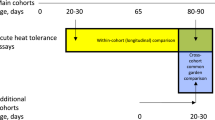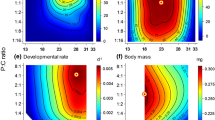Abstract
Temperature-mediated plasticity in life history traits strongly affects the capability of ectotherms to cope with changing environmental temperatures. We hypothesised that temperature-mediated reaction norms of ectotherms are constrained by the availability of essential dietary lipids, i.e. polyunsaturated fatty acids (PUFA) and sterols, as these lipids are involved in the homeoviscous adaptation of biological membranes to changing temperatures. A life history experiment was conducted in which the freshwater herbivore Daphnia magna was raised at four different temperatures (10, 15, 20, 25°C) with food sources differing in their PUFA and sterol composition. Somatic growth rates increased significantly with increasing temperature, but differences among food sources were obtained only at 10°C at which animals grew better on PUFA-rich diets than on PUFA-deficient diets. PUFA-rich food sources resulted in significantly higher population growth rates at 10°C than PUFA-deficient food, and the optimum temperature for offspring production was clearly shifted towards colder temperatures with an increased availability of dietary PUFA. Supplementation of PUFA-deficient food with single PUFA enabled the production of viable offspring and significantly increased population growth rates at 10°C, indicating that dietary PUFA are crucial for the acclimation to cold temperatures. In contrast, cumulative numbers of viable offspring increased significantly upon cholesterol supplementation at 25°C and the optimum temperature for offspring production was shifted towards warmer temperatures, implying that sterol requirements increase with temperature. In conclusion, essential dietary lipids significantly affect temperature-mediated reaction norms of ectotherms and thus temperature-mediated plasticity in life history traits is subject to strong food quality constraints.



Similar content being viewed by others
References
Angilletta MJ Jr, Steury TD, Sears MW (2004) Temperature, growth rate, and body size in ecotherms: fitting pieces of a life-history puzzle. Integr Comp Biol 44:498–509. doi:10.1093/icb/44.6.498
Atkinson D (1995) Effects of temperature on the size of aquatic ectotherms: exceptions to the general rule. J Therm Biol 20:61–74. doi:10.1016/0306-4565(94)00028-H
Atkinson D, Sibly RM (1997) Why are organisms usually bigger in colder environments? Making sense of a life history puzzle. Trends Ecol Evol 12:235–239. doi:10.1016/S0169-5347(97)01058-6
Becker C, Boersma M (2003) Resource quality effects on life histories of Daphnia. Limnol Oceanogr 48:700–706. doi:10.4319/lo.2003.48.2.0700
Behmer ST, Nes WD (2003) Insect sterol nutrition and physiology: a global overview. Adv Insect Physiol 31:1–72. doi:10.1016/S0065-2806(03)31001-X
Colbourne JK, Pfrender ME, Gilbert D, Thomas WK, Tucker A, Oakley TH, Tokishita S, Aerts A, Arnold GJ, Basu MK, Bauer DJ, Cáceres CE, Carmel L, Casola C, Choi J-H, Detter JC, Dong Q, Dusheyko S, Eads BD, Fröhlich T, Geiler-Samerotte KA, Gerlach D, Hatcher P, Jogdeo S, Krijgsveld J, Kriventseva EV, Kültz D, Laforsch C, Lindquist E, Lopez J, Manak JR, Muller J, Pangilinan J, Patwardhan RP, Pitluck S, Pritham EJ, Rechtsteiner A, Rho M, Rogozin IB, Sakarya O, Salamov A, Schaack S, Shapiro H, Shiga Y, Skalitzky C, Smith Z, Souvorov A, Sung W, Tang Z, Tsuchiya D, Tu H, Vos H, Wang M, Wolf YI, Yamagata H, Yamada T, Ye Y, Shaw JR, Andrews J, Crease TJ, Tang H, Lucas SM, Robertson HM, Bork P, Koonin EV, Zdobnov EM, Grigoriev IV, Lynch M, Boore JL (2011) The ecoresponsive genome of Daphnia pulex. Science 331:555–561. doi:10.1126/science.1197761
Crockett EL (1998) Cholesterol function in plasma membranes from ectotherms: membrane-specific roles in adaptation to temperature. Am Zool 38:291–304
Crockett EL (2008) The cold but not hard fats in ectotherms: consequences of lipid restructuring on susceptibility of biological membranes to peroxidation, a review. J Comp Physiol B 178:795–809. doi:10.1007/s00360-008-0275-7
Cunnane SC (2000) The conditional nature of the dietary need for polyunsaturates: a proposal to reclassify ‘essential fatty acids’ as ‘conditionally-indispensable’ or ‘conditionally-dispensable’ fatty acids. Br J Nutr 84:803–812. doi:10.1017/S0007114500002415
Dixit SK, Ray HS (1982) Use of reciprocal temperature rise equation in analysis of non-isothermal kinetic data in general. Thermochim Acta 54:245–250. doi:10.1016/0040-6031(82)80013-0
Ebert D (2011) A genome for the environment. Science 331:539–540. doi:10.1126/science.1202092
Farkas T (1979) Adaptation of fatty-acid compositions to temperature—a study on planktonic crustaceans. Comp Biochem Physiol 64B:71–76
Gliwicz ZM, Boavida MJ (1996) Clutch size and body size at first reproduction in Daphnia pulicaria at different levels of food and predation. J Plankton Res 18:863–880. doi:10.1093/plankt/18.6.863
Haines TH (2001) Do sterols reduce proton and sodium leaks through lipid bilayers? Prog Lipid Res 40:299–324. doi:10.1016/S0163-7827(01)00009-1
Hassett RP, Crockett EL (2009) Habitat temperature is an important determinant of cholesterol contents in copepods. J Exp Biol 212:71–77. doi:10.1242/jeb.020552
Hazel JR, Prosser CL (1974) Molecular mechanisms of temperature compensation in poikilotherms. Physiol Rev 54:620–677
Hazel JR, Williams E (1990) The role of alterations in membrane lipid composition in enabling physiological adaptation of organisms to their physical environment. Prog Lipid Res 29:167–277. doi:10.1016/0163-7827(90)90002-3
Heckmann LH, Sibly RM, Timmermans MJTN, Callaghan A (2008) Outlining eicosanoid biosynthesis in the crustacean Daphnia. Front Zool 5:11. doi:10.1186/1742-9994-5-11
Jüttner F, Leonhardt J, Möhren S (1983) Environmental factors affecting the formation of mesityloxid, dimethylallylic alcohol and other volatile compounds excreted by Anabaena cylindrica. J Gen Microbiol 129:407–412
Keating KI (1985) The influence of vitamin B12 deficiency on the reproduction of Daphnia pulex Leydig (Cladocera). J Crustac Biol 5:130–136
Leonard AE, Pereira SL, Sprecher H, Huang YS (2004) Elongation of long-chain fatty acids. Prog Lipid Res 43:36–54. doi:10.1016/S0163-7827(03)00040-7
Lynch M (1980) The evolution of cladoceran life histories. Q Rev Biol 55:23–42
Martin-Creuzburg D, von Elert E (2009) Ecological significance of sterols in aquatic food webs. In: Arts MT, Brett MT, Kainz MJ (eds) Lipids in aquatic ecosystems. Springer, New York, pp 43–64
Martin-Creuzburg D, Wacker A, von Elert E (2005) Life history consequences of sterol availability in the aquatic keystone species Daphnia. Oecologia 144:362–372. doi:10.1007/s00442-005-0090-8
Martin-Creuzburg D, Sperfeld E, Wacker A (2009) Colimitation of a freshwater herbivore by sterols and polyunsaturated fatty acids. Proc R Soc Lond B 276:1805–1814. doi:10.1098/rspb.2008.1540
Martin-Creuzburg D, Wacker A, Basen T (2010) Interactions between limiting nutrients: consequences for somatic and population growth of Daphnia magna. Limnol Oceanogr 55:2597–2607. doi:10.4319/lo.2010.55.6.2597
Masclaux H, Bec A, Kainz MJ, Desvilettes C, Jouve L, Bourdier G (2009) Combined effects of food quality and temperature on somatic growth and reproduction of two freshwater cladocerans. Limnol Oceanogr 54:1323–1332. doi:10.4319/lo.2009.54.4.1323
Mitchell SE, Lampert W (2000) Temperature adaptation in a geographically widespread zooplankter, Daphnia magna. J Evol Biol 13:371–382. doi:10.1046/j.1420-9101.2000.00193.x
Mitchell SE, Halves J, Lampert W (2004) Coexistence of similar genotypes of Daphnia magna in intermittent populations: response to thermal stress. Oikos 106:469–478. doi:10.1111/j.0030-1299.2004.13113.x
Ohvo-Rekilä H, Ramstedt B, Leppimäki P, Slotte P (2002) Cholesterol interactions with phospholipids in membranes. Prog Lipid Res 41:66–97. doi:10.1016/S0163-7827(01)00020-0
Piepho M, Martin-Creuzburg D, Wacker A (2010) Simultaneous effects of light intensity and phosphorus supply on the sterol content of phytoplankton. PloS ONE 5(12):e15828. doi:10.1371/journal.pone.0015828
Ravet JL, Brett MT, Müller-Navarra DC (2003) A test of the role of polyunsaturated fatty acids in phytoplankton food quality for Daphnia using liposome supplementation. Limnol Oceanogr 48:1938–1947. doi:10.4319/lo.2003.48.5.1938
Schlechtriem C, Arts MT, Zellmer ID (2006) Effect of temperature on the fatty acid composition and temporal trajectories of fatty acids in fasting Daphnia pulex (Crustacea, Cladocera). Lipids 41:397–400. doi:10.1007/s11745-006-5111-9
Sinensky M (1974) Homeoviscous adaptation—a homeostatic process that regulates viscosity of membrane lipids in Escherichia coli. Proc Natl Acad Sci USA 71:522–525
Smyntek PM, Teece MA, Schulz KL, Storch AJ (2008) Taxonomic differences in the essential fatty acid composition of groups of freshwater zooplankton relate to reproductive demands and generation time. Freshw Biol 53:1768–1782. doi:10.1111/j.1365-2427.2008.02001.x
Sperfeld E, Wacker A (2009) Effects of temperature and dietary sterol availability on growth and cholesterol allocation of the aquatic keystone species Daphnia. J Exp Biol 212:3051–3059. doi:10.1242/jeb.031401
Sperfeld E, Wacker A (2011) Temperature- and cholesterol-induced changes in eicosapentaenoic acid limitation of Daphnia magna determined by a promising method to estimate growth saturation thresholds. Limnol Oceanogr 56:1273–1284. doi:10.4319/lo.2011.56.4.1273
Stanley DW (2000) Eicosanoids in invertebrate signal transduction systems. Princeton University Press, Princeton
Von Elert E (2002) Determination of limiting polyunsaturated fatty acids in Daphnia galeata using a new method to enrich food algae with single fatty acids. Limnol Oceanogr 47:1764–1773. doi:10.4319/lo.2002.47.6.1764
Watson SB, Caldwell G, Pohnert G (2009) Fatty acids and oxylipins as semiochemicals. In: Arts MT, Brett MT, Kainz MJ (eds) Lipids in aquatic ecosystems. Springer, New York, pp 65–91
Zar JH (2010) Biostatistical analysis. Prentice Hall/Pearson, London
Acknowledgments
We thank P. Merkel for technical assistance. E. Sperfeld and N. Schlotz provided valuable comments on an earlier draft of this manuscript.
Author information
Authors and Affiliations
Corresponding author
Additional information
Communicated by Carla Caceres.
Rights and permissions
About this article
Cite this article
Martin-Creuzburg, D., Wacker, A., Ziese, C. et al. Dietary lipid quality affects temperature-mediated reaction norms of a freshwater key herbivore. Oecologia 168, 901–912 (2012). https://doi.org/10.1007/s00442-011-2155-1
Received:
Accepted:
Published:
Issue Date:
DOI: https://doi.org/10.1007/s00442-011-2155-1




